Labrador Retriever History
As family pets
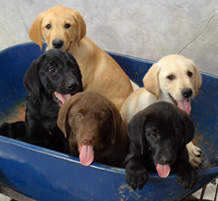
A Labrador retriever is easily trained and responds well to praise and positive attention. With proper training, they can become some of the most obedient, dependable, and multi-talented dog breeds in the world. Their trainability also makes them good working dogs.
The Labrador retriever is one of the most common breeds used in police, rescue, and assistant work. In addition to learning quickly, their patience allows them to sit quietly for long periods of time, so the Labrador retriever is often used to assist people with disabilities.
Their patience also makes them good pets for families, especially those with children. Many families choose to bring home a Labrador retriever because they are excellent family dogs.
They are playful, but gentle with people they know, so rambunctious children will not cause the dog to become agitated or frustrated. And because of their loyalty, they are protective, which makes them good guard dogs.
They are often thought of as the ideal family pet, and anyone who brings home a Labrador retriever will have a lifelong companion, and not just a best friend.
The Labrador Retriever (also Labrador, or Lab for short) is one of several kinds of retriever, a type of gun dog. A breed characteristic is webbed paws for swimming, useful for the breed's original purpose of retrieving fishing nets.
The Labrador is the most popular breed of dog by registered ownership in Canada, the United Kingdom, and the United States (since 1991). It is also one of the most popular assistance dog breeds in Australia, Canada, the United Kingdom and the United States and many other countries, as well as being widely used by police and other official bodies for their detection and working abilities. Typically, Labradors are athletic and love to swim, play catch and retrieve games, are good with young children, elderly, and for protection.
The white chest, feet, chin, and muzzle - known as tuxedo markings - characteristic of the St. John's Dog often appear in modern Lab mixes, and will occasionally manifest in Labradors as a white spot on the chest (known as a medallion) or stray white hairs on the feet or muzzle.
The breed tends to shed hair twice annually, or regularly throughout the year in temperate climates. Yellow Labradors shed considerably more.
Labradors have a reputation as a very even-tempered breed and an excellent family dog. This includes a good reputation with children of all ages and other animals. But some lines (particularly those that have continued to be bred specifically for their skills at working in the field rather than for their appearance) are particularly fast and athletic.
Labradors mature at around three years of age; before this time they can have a significant degree of puppy-like energy, often mislabeled as being hyperactive. Because of their enthusiasm, leash-training early on is suggested to prevent pulling when full-grown. Labradors often enjoy retrieving a ball endlessly and other forms of activity (such as agility, frisbee, or flyball). It is important to train puppies at an early age.
Although they will sometimes bark at noise, especially noise from an unseen source ("alarm barking"), Labradors are usually not noisy or territorial. They are often very easygoing and trusting with strangers, and therefore are not usually suitable as guard dogs. However they will be very protective of their attached owner.
The steady temperament of Labradors and their ability to learn make them an ideal breed for search and rescue, detection, and therapy work. They are a very intelligent breed. The AKC describes the breed as an ideal family and sporting dog. Their primary working role in the field continues to be that of a hunting retriever and top in service working dogs.
Labradors as a breed are curious, exploratory and Love Company, following both people and interesting scents for food, attention and novelty value.
Labradors are an intelligent breed with a good work ethic and generally good temperaments (breed statistics show that 92.3% of Labradors who were tested passed the American Temperament Test.) Common working roles for Labradors include: hunting, tracking and detection (they have a great sense of smell which helps when working in these areas), disabled-assistance, carting, and therapy work. Approximately 60–70% of all guide dogs in Canada are Labradors; other common breeds are Golden Retrievers and German Shepherd Dogs.
History
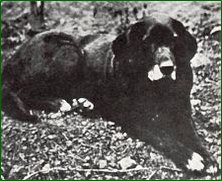
The modern Labrador's ancestors originated on the island of Newfoundland, now part of the province of Newfoundland and Labrador, Canada. The founding breed of the Labrador was the St. John's Water Dog, a breed that emerged through ad-hoc breedings by early settlers of the island in the 16th century. The forebears of the St. John's Dog are not known, but were likely a random-bred mix of English, Irish, and Portuguese working breeds. The Newfoundland (known then as the Greater Newfoundland) is likely a result of the St. John's Dog breeding with mastiffs brought to the island by the generations of Portuguese fishermen who had been fishing offshore since the 16th century. The smaller short-coated St. John's Dog (also known then as the Lesser Newfoundland) was used for retrieval and pulling in nets from the water. These smaller dogs were the forebears of the Labrador Retriever. The white chest, feet, chin, and muzzle - known as tuxedo markings - characteristic of the St. John's Dog often appear in modern Lab mixes, and will occasionally manifest in Labradors as a white spot on the chest (known as a medallion) or stray white hairs on the feet or muzzle.
The St. John's area of Newfoundland was settled mainly by the English and Irish. Local fishermen originally used the St. John's dog to assist in carrying ropes between boats, towing dories, and helping to retrieve fishnets in the water. The Labrador's loyalty and hard working behavior were valuable assets for fishermen.
A number of St. John's Dogs were brought back to the Poole area of England in the early 19th century, then the hub of the Newfoundland fishing trade, by the gentry, and became prized as sporting and waterfowl hunting dogs. A few kennels breeding these grew up in England; at the same time a combination of sheep protection policy (Newfoundland) and rabies quarantine (England) led to their gradual demise in their country of origin.
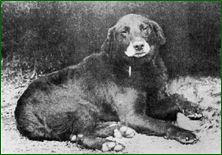
The first and second Earls of Malmesbury, who bred for duck shooting on his estate, and the 5th and 6th Dukes of Buccleuch, and youngest son Lord George William Montagu-Douglas-Scott, were instrumental in developing and establishing the modern Labrador breed in 19th century England. The dogs Avon ("Buccleuch Avon") and Ned given by Malmesbury to assist the Duke of Buccleuch's breeding program in the 1880s are considered the ancestors of modern Labradors.
The first St. John's dog was said to be brought to England around 1820; however, the breed's reputation had spread to England long before. There is a story that the Earl of Malmesbury saw a St. John's Dog on a fishing boat and immediately made arrangements with traders to have some of these dogs exported to England. These ancestors of the first Labradors so impressed the Earl with their skill and ability for retrieving anything within the water and on shore that he devoted his entire kennel to developing and stabilizing the breed.
Early descriptions
Several early descriptions of the St. John's Water Dog exist. In 1822, explorer W.E. Cormack crossed the island of Newfoundland by foot. In his journal he wrote "The dogs are admirably trained as retrievers in fowling, and are otherwise useful.....”The smooth or short haired dog is preferred because in frosty weather the long haired kind become encumbered with ice on coming out of the water.”
Another early report by a Colonel Hawker described the dog as "by far the best for any kind of shooting. He is generally black and no bigger than a Pointer, very fine in legs, with short, smooth hair and does not carry his tail so much curled as the other; is extremely quick, running, swimming and fighting....and their sense of smell is hardly to be credited...."
In his book Excursions In and About Newfoundland During the Years 1839 and 1840, geologist Joseph Beete Jukes describes the St. John's Water Dog. "A thin, short-haired, black dog came off-shore to us to-day. The animal was of a breed very different from what we understand by the term Newfoundland dog in England. He had a thin, tapering snout, a long thin tail, and rather thin, but powerful legs, with a lank body, – the hair short and smooth." wrote Jukes. "These are the most abundant dogs in the country... They are no means handsome, but are generally more intelligent and useful than the others... I observed he once or twice put his foot in the water and paddled it about. This foot was white, and Harvey said he did it to "toil" or entice the fish. The whole proceeding struck me as remarkable, more especially as they said he had never been taught anything of the kind.
Name
The foundational breed of what is now the Labrador Retriever was known as the St. John's Water Dog, St. John's Dog, or Lesser Newfoundland. When the dogs were later brought to England, they were named after the geographic area known as "the Labrador" or simply Labrador to distinguish them from the larger Newfoundland breed, even though the breed was from the more southern Avalon Peninsula.
Historical landmarks
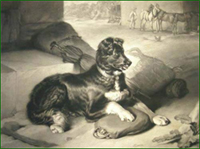
The first written reference to the breed was in 1814 ("Instructions to Young Sportsmen" by Colonel Peter Hawker), the first painting in 1823 ("Cora. A Labrador" by Edwin Landseer), and the first photograph in 1856 (the Earl of Home's dog "Nell", described both as a Labrador and a St. Johns dog). By 1870 the name Labrador Retriever became common in England.
Yellow and chocolate pups, would occasionally appear (although often culled(killed), until finally gaining acceptance in the 20th century. The first yellow Labrador on record was born in 1899 (Ben of Hyde, kennels of Major C.J. Radclyffe), and the breed was recognized by The Kennel Club in 1903. The first American Kennel Club (AKC) registration was in 1917. The chocolate Labrador emerged in the 1930s, although liver spotted pups were documented being born at the Buccleuch kennels in 1892. The St. John's dog survived until the early 1980s, the last two individuals being photographed in old age around 1981.
History of subtypes
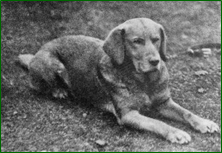
In the early years of the breed through to the mid-20th century, Labradors of a shade we would now call "yellow" were in fact a dark, almost butterscotch, colour (visible in early yellow Labrador photographs). The shade was known as "Golden" until required to be changed by the UK Kennel Club, on the grounds that "Gold" was not actually a colour. Over the 20th century a preference for far lighter shades of yellow through to cream prevailed, until today most yellow Labradors are of this shade. Also fawn has been a common colour in the yellow lab variety.
Interest in the darker shades of gold and fox red were re-established by English breeders in the 1980s, and three dogs were instrumental in this change: Balrion King Frost (black, born approx. 1976) who consistently sired "very dark yellow" offspring and is credited as having "the biggest influence in the re-development of the fox red shade", and his great-grandson, the likewise famous Wynfaul Tabasco (b.1986), described as "the father of the modern fox red Labrador", and the only modern fox red Show Champion in the UK. Other dogs, such as Red Alert and Scrimshaw Placido Flamingo, are also credited with passing on the genes into more than one renowned bloodline.
Chocolate Labradors
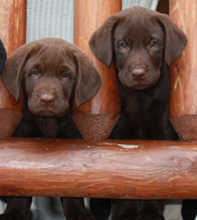
Jack Vanderwyk traces the origins of all Chocolate Labradors listed on the LabradorNet database (some 34,000 Labrador dogs of all shades) to eight original bloodlines. However, the shade was not seen as a distinct colour until the 20th century; before then according to Vanderwyk, such dogs can be traced but were not registered. A degree of crossbreeding with Flatcoat or Chesapeake Bay retrievers was also documented in the early 20th century, prior to recognition. Chocolate labradors were also well established in the early 20th century at the kennels of the Earl of Feversham, and Lady Ward of Chiltonfoliat.
The bloodlines as traced by Vanderwyk each lead back to three black labradors in the 1880s—Buccleuch Avon (m), and his sire and dam, Malmesbury Tramp (m), and Malmesbury June (f). Morningtown Tobla is also named as an important intermediary, and according to the studbook of Buccleuch Kennels, the chocolates in this kennel came through FTW Peter of Faskally (1908).
Description
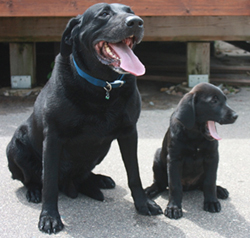
Appearance
Labradors are relatively large, with males typically weighing 29 to 41 kg (64 to 90 lb) and females 25 to 32 kg (55 to 71 lb). Some Labradors weighing close to or over 100 lb (45 kg) is possible dependant on English or American breeding. The majority of the characteristics of this breed, with the exception of colour, are the result of breeding to produce a working retriever.
As with some other breeds, the Conformation (typically "English", "show" or "bench") and the Field (typically "American" or "working") lines differ, although both lines are bred in both countries. In general, however, Conformation Labradors tend to be bred as medium-sized dogs, shorter and stockier with fuller faces and a slightly calmer nature than their Field counterparts, which are often bred as taller, lighter-framed dogs, with slightly less broad faces and a slightly longer nose; however Field Labradors should still be proportional. These two types come from different breeding lines. Australian stock also exists; though not seen in the west, they are common in Asia.
The breed tends to shed hair twice annually, or regularly throughout the year in temperate climates. Some Labradors shed considerably especially yellow labs; however, individual Labradors vary. Labrador hair is usually fairly short and straight, and the tail quite broad and strong. The webbed toes of the Labrador Retriever make them excellent swimmers. The webbing between their toes can also serve as a "snowshoe" in colder climates and keep snow from balling up between their toes- a condition that can be painful to other breeds with hair between the toes. Their interwoven coat is also relatively waterproof, providing more assistance for swimming.
Colour
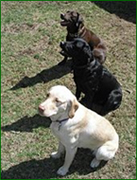
Labrador Retrievers are registered in three colours: black (a solid black colour), yellow (anything from light cream to "fox-red"), and chocolate (medium to dark brown). Some Labrador retrievers can have markings such as white patches on their chest and other areas but mostly solid color.
Puppies of all colours can potentially occur in the same litter. Colour is determined primarily by three genes.
- The first gene (the B locus) determines the density of the coat's eumelanin pigment granules, if that pigment is allowed: dense granules result in a black coat, sparse ones give a chocolate coat.
- The second (E) locus determines whether the eumelanin is produced at all. A dog with the recessive e allele will produce only phaeomelanin pigment and will be yellow regardless of its genotype at the B locus.
- The genes known about previously have had their number increased by the introduction of the K locus, where the dominant "black" allele KB is now known to reside. Black or chocolate Labradors therefore must have the KB allele.
- Yellow Labradors are determined at the E locus, so the K locus is irrelevant in determining their colour. Variations in numerous other genes control the subtler details of the coat's colouration, which in yellow Labradors varies from white to light gold to a fox red. Chocolate and black Labradors' noses will match the coat colour.
According to a 2011 study, 13 out of 245 Labradors studied were heterozygous for the M264V mutation responsible for the melanistic mask, and one was homozygous. Within the breed, this trait is not visible.
Nose and skin pigmentation
Because Labrador coloration is controlled by multiple genes, it is possible for recessive genes to emerge some generations later and also there can sometimes be unexpected pigmentation effects to different parts of the body. Pigmentation effects appear in regard to yellow Labradors, and sometimes chocolate, and hence the majority of this section covers pigmentation within the yellow Labrador. The most common places where pigmentation is visible are the nose, lips, gums, feet, tail, and the rims of the eyes, which may be black, brown, light yellow-brown ("liver", caused by having two genes for chocolate), or several other colours. A Labrador can carry genes for a different color, for example a black Labrador can carry recessive chocolate and yellow genes, and a yellow Labrador can carry recessive genes for the other two colors.
DNA testing can reveal some aspects of these. Less common pigmentations (other than pink) are a fault, not a disqualification. The intensity of black pigment on yellow Labradors is controlled by a separate gene independent of the fur coloring. Yellow Labradors usually have black noses, which may gradually turn pink with age (called "snow nose" or "winter nose"). This is due to a reduction in the enzyme tyrosinase which indirectly controls the production of melanin, a dark coloring. Tyrosinase is temperature dependent—hence light colouration can be seasonal, due to cold weather—and is less produced with increasing age two years old onwards. As a result, the nose color of most yellow Labradors becomes a somewhat pink shade as they grow older.
A colouration known as "Dudley" is also possible. Dudleys are variously defined as yellow Labradors which have unpigmented (pink) noses (LRC), yellow with liver/chocolate pigmentation (AKC), or "flesh coloured" in addition to having the same colour around the rims of the eye, rather than having black or dark brown pigmentation. A yellow Labrador with brown or chocolate pigmentation, for example, a brown or chocolate nose, is not necessarily a Dudley, it would be if it has chocolate rims around the eyes (or more accurately of the genotype eebb). Breed standards for Labradors considers a true Dudley to be a disqualifying feature in a conformation show Lab, such as one with a thoroughly pink nose or one lacking in any pigment along with flesh coloured rims around the eyes. True Dudleys are extremely rare.
Breeding in order to correct pigmentation often lacks dependability. Because colour is determined by many genes, some of which are recessive, crossbreeding a pigmentation non-standard yellow Labrador to a black Labrador may not correct the matter or prevent future generations carrying the same recessive genes. For similar reasons, crossbreeding chocolate to yellow Labradors is also often avoided.
Show and field lines
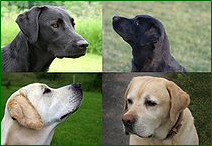
Head and muzzle appearance: American or field (left), and English or show (right), showing the shorter muzzle length, more solid appearance head, and "pronounced" stop of the latter.
There are significant differences between field and trial-bred (sometimes referred to as "American") and show-bred (or "English") lines of Labradors, arising as a result of specialized breeding. Dogs bred for hunting and field-trial work are selected first for working ability, where dogs bred to compete in conformation shows are selected for their conformation to the standards and characteristics sought by judges in the show ring.
While individual dogs may vary, in general show-bred Labradors are heavier built, slightly shorter-bodied, and have a thicker coat and tail. Field Labradors are generally longer legged, lighter, and more lithe in build. In the head, show Labradors tend to have broader heads, better defined stops, and more powerful necks, while field Labradors have lighter and slightly narrower heads with longer muzzles.
In the United States, the AKC and the Labrador's breed club have set the breed standard to accommodate the field-bred Labrador somewhat. For instance, the AKC withers-height standards allow conformation dogs to be slightly taller than the equivalent British standard. However, dual champions, or dogs that excel in both the field and the show ring, are becoming more unusual.
Temperament
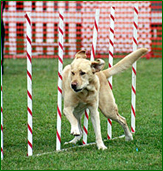
The AKC describes the Labrador's temperament as a kind, outgoing and tractable nature. Labradors' sense of smell allows them to hone in on almost any scent and follow the path of its origin. They generally stay on the scent until they find it. Labradors instinctively enjoy holding objects and even hands or arms in their mouths, which they can do with great gentleness (a Labrador can carry an egg in its mouth without breaking it). They are also known to have a very soft feel to the mouth, as a result of being bred to retrieve game such as waterfowl. They are prone to chewing objects (though they can be trained out of this behavior). The Labrador Retriever's coat repels water to some extent, thus facilitating the extensive use of the dog in waterfowl hunting.
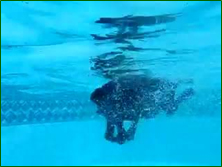
Labradors have a reputation as a very even-tempered breed and an excellent family dog. This includes a good reputation with children of all ages and other animals. But some lines (particularly those that have continued to be bred specifically for their skills at working in the field rather than for their appearance) are particularly fast and athletic. Their fun-loving boisterousness and lack of fear may require training and firm handling at times to ensure it does not get out of hand—an uncontrolled adult can be quite problematic, along with any other untrained dog. Females may be slightly more independent than males. Labradors mature at around three years of age; before this time they can have a significant degree of puppy-like energy, often mislabeled as being hyperactive. Because of their enthusiasm, leash-training early on is suggested to prevent pulling when full-grown. Labradors often enjoy retrieving a ball endlessly and other forms of activity (such as agility, frisbee, or flyball). It is important to train puppies at an early age.
Although they will sometimes bark at noise, especially noise from an unseen source ("alarm barking"), Labradors are usually not noisy or territorial. They are often very easygoing and trusting with strangers, and therefore are not usually suitable as guard dogs. However they will be very protective of their attached owner.
Labradors have a well-known reputation for appetite, and some individuals may be highly indiscriminate, eating digestible and non-food objects alike. They are persuasive and persistent in requesting food. Keep from giving your dog sugar snacks and allow more like apples with peanut butter or celery, carrots or other vegetables. Keeping their food out at all times will help them regulate their intake.
The steady temperament of Labradors and their ability to learn make them an ideal breed for search and rescue, detection, and therapy work. They are a very intelligent breed. The AKC describes the breed as an ideal family and sporting dog. Their primary working role in the field continues to be that of a hunting retriever and top in service working dogs.
Exploration
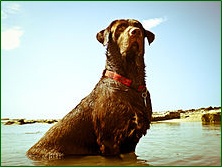
Labradors do not typically jump high fences or dig. Because of their personalities, some Labradors climb and/or jump for their own amusement. As a breed they are highly intelligent and capable of intense single-mindedness and focus if motivated or their interest is caught. Therefore, with the right conditions and stimuli, a bored Labrador could "turn into an escape artist par excellence".
Labradors as a breed are curious, exploratory and love company, following both people and interesting scents for food, attention and novelty value. In this way, they can often "vanish" or otherwise become separated from their owners with little fanfare. Sadly, many dogs are also stolen. Because of their curious nature and ability to "vanish," along with the risk of being stolen, a number of dog clubs and rescue organizations (including the UK's Kennel Club) consider it good practice that Labradors be micro chipped, with the owner's name and address also on their collar and tags.
Use as working dogs
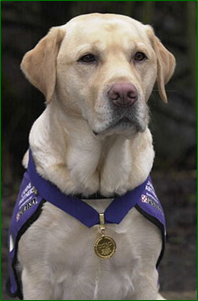
Labradors are an intelligent breed with a good work ethic and generally good temperaments (breed statistics show that 92.3% of Labradors who were tested passed the American Temperament Test.) Common working roles for Labradors include: hunting, tracking and detection (they have a great sense of smell which helps when working in these areas), disabled-assistance, carting, and therapy work. Approximately 60–70% of all guide dogs in Canada are Labradors; other common breeds are Golden Retrievers and German Shepherd Dogs.
Labradors are powerful and indefatigable swimmers noted for their ability to tolerate the coldest of water for extended periods of time. Their ability to work quietly alongside hunters while watching for birds to fall from the sky, marking where they land, and then using their outstanding nose to find and retrieve dead or wounded birds has made them the king of waterfowl retrievers. They are also used for pointing and flushing and make excellent upland game hunting partners.
Endal (13 December 1995 – 13 March 2009) was a male Labrador retriever in Britain whose abilities as a service dog and as an ambassador for service dog charitable work have had considerable news media coverage.
The high intelligence, initiative and self-direction of Labradors in working roles is exemplified by dogs such as Endal, who during a 2001 emergency placed an unconscious human being in the recovery position, retrieved his mobile phone from beneath the car, fetched a blanket and covered him, barked at nearby dwellings for assistance, and then ran to a nearby hotel to obtain help. A number of Labradors have also been taught to assist their owner in removing money and credit cards from ATMs with prior training. The breed is used in water rescue/lifesaving. It continues in that role today, along with the Leonberger, Newfoundland and Golden Retriever dogs; they are used at the Italian School of Canine Lifeguard.
Health
Many dogs, including Labradors such as this twelve year old, show distinct whitening of the coat as they grow older; especially around the muzzle.
Labrador pups generally are not brought to the home before they are 8 weeks old. Their life expectancy is generally 10 to 12 years, and it is a healthy breed with relatively few major problems. Notable issues related to health and well-being include:
Inherited disorders
Labradors are somewhat prone to hip and elbow dysplasia, especially the larger dogs, though not as much as some other breeds. Hip scores are recommended before breeding and often joint supplements are recommended if not in the food they eat.
Labradors also suffer from the risk of knee problems. A luxating patella is a common occurrence in the knee where the knee dislocates and goes back into place.
Eye problems are also possible in some Labradors, particularly progressive retinal atrophy, cataracts, corneal dystrophy and retinal dysplasia. Dogs which are intended to be bred should be examined by a veterinary ophthalmologist for an eye score.
Hereditary myopathy, a rare inherited disorder that causes a deficiency in type II muscle fibre. Symptoms include a short stilted gait or "bunny hopping," and in rare cases ventroflexion of the neck accompanied by a kyphotic posture.
There is a small incidence of other conditions, such as autoimmune diseases and deafness in Labradors, either congenitally or later in life.
Labradors often suffer from exercise induced collapse, a syndrome that causes hyperthermia, weakness, collapse, and disorientation after short bouts of exercise.
A healthy Labrador can do swimming wind sprints for two hours, and should keep a very slight hourglass waist and be fit and light, rather than fat or heavy-set. Obesity can exacerbate conditions such as hip dysplasia and joint problems, and can lead to secondary diseases, including diabetes. Osteoarthritis is common in older, especially overweight, Labradors. Labradors who maintained a lean body shape outlived those that were fat, by around two years, emphasizing the importance of feeding bad foods. Labradors should be walked twice a day for at least half an hour.
Appearance around the world
In the United States, the breed gained wider recognition following a 1928 American Kennel Gazette article, "Meet the Labrador Retriever". Before this time, the AKC had only registered 23 Labradors in the country, in part because US and UK hunting styles had different requirements. Labradors acquired popularity as hunting dogs during the 1920s and especially after World War II, as they gained recognition as combining some of the best traits of the two favorite United States breeds as both game finders and water dogs.
Outside North America and Western Europe, the Labrador arrived later. For example, the Russian Retriever Club traces the arrival of Labradors to the late 1960s, as household pets of diplomats and others in the foreign ministry. The establishment of the breed in the Commonwealth of Independent States (former USSR) was initially hindered by the relatively small numbers of Labradors and great distances involved, leading to difficulty establishing breedings and bloodlines; at the start of the 1980s, home-born dogs were still regularly supplemented by further imports from overseas. Difficulties such as these initially led to Labradors being tacitly cross-bred to other types of retriever. In the 1990s, improved access to overseas shows and bloodlines is said to have helped this situation become regularized.
Demography
The Labrador is an exceptionally popular dog. For example as of 2006:
Widely considered the most popular breed in the world.
Most popular dog by ownership in Australia, Canada, Israel, New Zealand, UK, and USA (since 1991).
In both the UK and USA, there are well over twice as many Labradors registered as the next most popular breed. If the comparison is limited to dog breeds of a similar size, then there are around 3 - 5 times as many Labradors registered in both countries as the next most popular breeds, the German Shepherd and Golden Retriever.
Most popular breed of assistance dog in the United States, Australia and many other countries, as well as being widely used by police and other official bodies for their detection and working abilities. Approximately 60–70% of all guide dogs in the United States are Labradors.
There is no global registry of Labradors, nor detailed information on numbers of Labradors living in each country. The countries with the five largest numbers of Labrador registrations as of 2005 are: 1: United Kingdom 2: France and United States (approximately equal), 4: Sweden, 5: Finland. Sweden and Finland have far lower populations than the other three countries, suggesting that as of 2005 these two countries have the highest proportion of Labradors per million people:
| Country | Population (millions) | Labrador registrations | Registrations per million pop. |
|---|---|---|---|
| Finland | 5.2 | 2,236 | 426.0 |
| France | 60.5 | 9,281 | 153.4 |
| Sweden | 9.0 | 5,158 | 570.5 |
| United Kingdom | 59.7 | 18,554 | 311.0 |
| USA | 307.0 | 10,833 | 36.3 |
OFA statistics suggest that yellow and black Labradors are registered in very similar numbers (yellow slightly more than black); chocolate in lesser numbers.
Note: number of registrations is not necessarily the same as number of living dogs at any given time.
US Military Working Dogs (War Dogs); Labrador Retrievers in the Vietnam War
The Vietnam War is the only war in American history in which US war dogs, which were officially classified by the military as "military working dogs" were not allowed to officially return home after the war. Classified as expendable equipment, of the approximate 4,000 US K-9s deployed to the Vietnam War it is estimated that only about 200 US war dogs survived Vietnam to be put into service at other out posts stationed over-seas.
The predominate canine selected by the US Military during the Vietnam War was the German Shepherd which was utilized in the roles of Scout Dogs, Sentry Dogs, Mine Detection Dogs, and the US Navy used Water Dogs to detect enemy under water divers in South Vietnam. The Labrador Retriever was the military's choice for their Combat Tracker Teams (CTTs). Combat Tracker Teams consisted of one Labrador and four men; the handler, an observer, a security man, and the team leader. Labradors were selected by the military for tracking because of their distinct smelling qualities, and were utilized to locate wounded US servicemen, enemy patrols, and downed allied airmen in Vietnam. The US Army Labrador Retrievers received their combat training at the British Army's Jungle Warfare School in Malaysia.
Of the over 4,000 US war dogs serving in the Vietnam War 232 were killed in action, and 295 US servicemen deployed as "dog handlers" were killed in action, of which one dog handler was awarded the Congressional Medal of Honor. Of these numbers 6 Labrador Retrievers were killed in battle while assigned to the 62nd and 63rd US Army Combat Tracking Teams. During the course of the war the US Army lost 204 dogs, while the US Marine Corps and US Air Force lost 13 and 15 dogs respectively.
In November 2000 President Clinton signed into law an amendment that allowed retired US military working dogs (war dogs) to be adopted by personnel outside of the military, leaving the Vietnam War as the only war in US history in which American war dogs never returned home.
Labrador hybrids
Further information: Dog hybrids and crossbreeds
The Labradoodle is a "designer dog" that is a cross-bred Labrador and Poodle. A concept that originated in Australia, the intent of breeding this cross was to try and create a service dog suitable for allergy sufferers. However, there is no guarantee such a cross will inherit the hypo-allergenic poodle coat, nor all poodles have such coat. The man who bred the first labradoodle - and in the process made the mutt a desirable accessory - says it's the great regret of his life.
PLEASE, quit the breeding and stop buying mutts!! They are destroying the heritage and quality of the breed and filling up the Humane Societies with more mutts!

